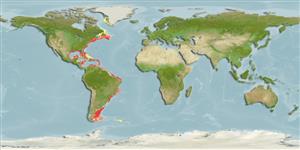>
Ophidiiformes (Cusk eels) >
Carapidae (Pearlfishes) > Carapinae
Etymology: Echiodon: Greek, echieys, eos = a little viper + Greek, odous = teeth (Ref. 45335); dawsoni: Named for Charles E. Dawson (Ref. 6347).
Eponymy: Charles Eric ‘Chuck’ Dawson (1922–1993) was a Canadian-born American ichthyologist. [...] (Ref. 128868), visit book page.
Environment: milieu / climate zone / depth range / distribution range
นิเวศวิทยา
เกี่ยวกับทะเล,น้ำเค็ม สัตว์น้ำหน้าดิน; ระดับความลึก 60 - 180 m (Ref. 10704). Tropical
Western Central Atlantic: northeastern Gulf of Mexico and the Straits of Florida. Northwest Atlantic: Canada (Ref. 5951).
ขนาด / น้ำหนัก / Age
Maturity: Lm ? range ? - ? cm
Max length : 11.2 cm TL เพศผู้/กระเทย; (Ref. 6347)
Eel-like, shallow body depth; 1 to several symphyseal fangs on dentary and premaxilla; lacking cardiform teeth, pelvic fins, and swim bladder rocker bone; a patch of ridges posteriorly on the ventral surface of the swim bladder (Ref. 34024). 39-43 anal fin rays in front of vertical through back of 30th vertebrae; 11-12 anal fin rays in front of vertical through dorsal fin origin (Ref. 34024).
Uncommon species (Ref. 34024).
Nielsen, J.G., D.M. Cohen, D.F. Markle and C.R. Robins, 1999. Ophidiiform fishes of the world (Order Ophidiiformes). An annotated and illustrated catalogue of pearlfishes, cusk-eels, brotulas and other ophidiiform fishes known to date. FAO Fish. Synop. 125(18):178p. Rome: FAO. (Ref. 34024)
IUCN Red List Status (Ref. 130435: Version 2024-2)
Threat to humans
Harmless
Human uses
การประมง: ไม่มีผลประโยชน์
เครื่องมือ
Special reports
Download XML
แหล่งที่มาจากอินเตอร์เน็ต
Estimates based on models
Preferred temperature (Ref.
123201): 2.4 - 25.3, mean 7.7 °C (based on 239 cells).
Phylogenetic diversity index (Ref.
82804): PD
50 = 0.5001 [Uniqueness, from 0.5 = low to 2.0 = high].
Bayesian length-weight: a=0.00102 (0.00046 - 0.00225), b=3.06 (2.88 - 3.24), in cm total length, based on all LWR estimates for this body shape (Ref.
93245).
ระดับชั้นอาหาร (Ref.
69278): 3.5 ±0.5 se; based on size and trophs of closest relatives
Fishing Vulnerability (Ref.
59153): Low vulnerability (10 of 100).
